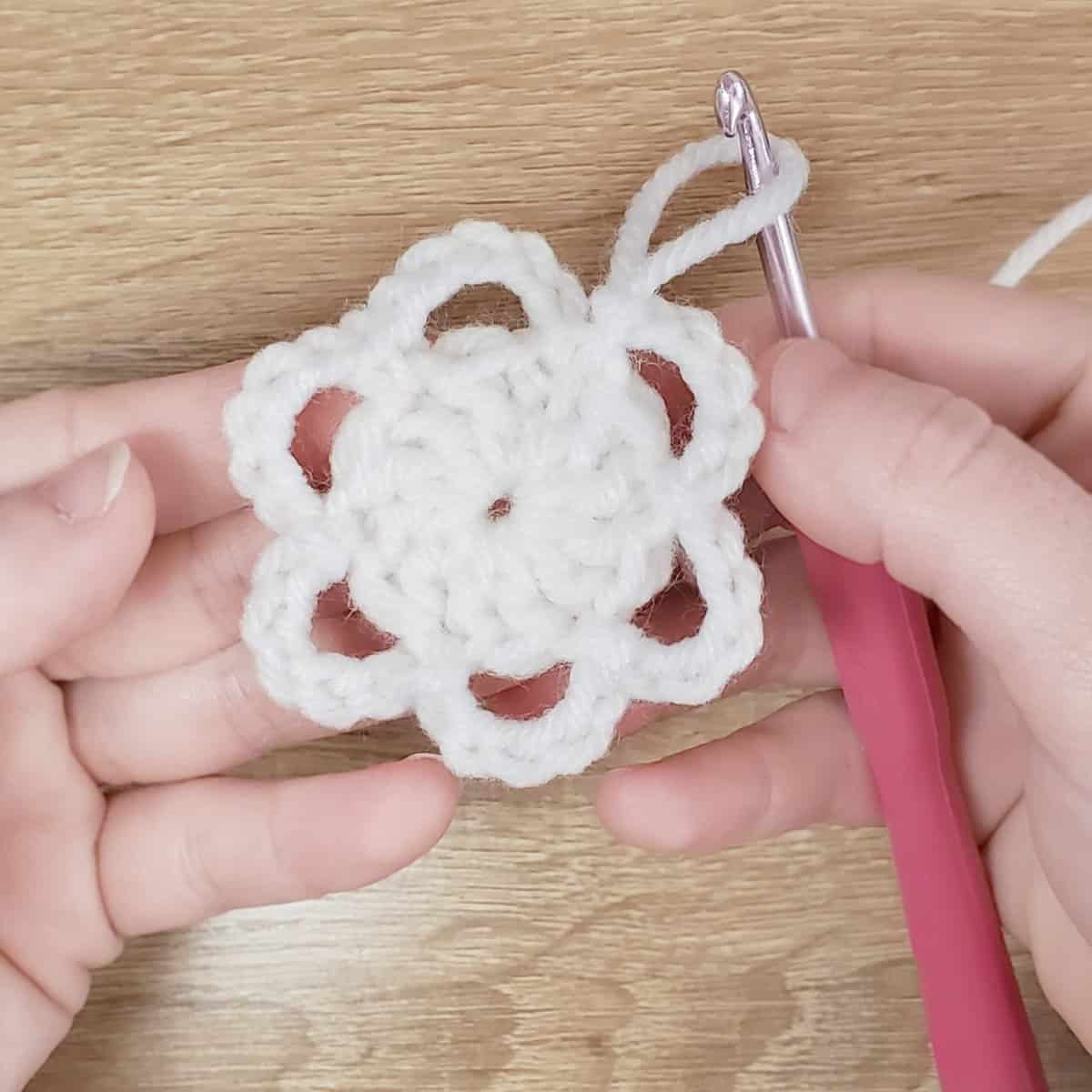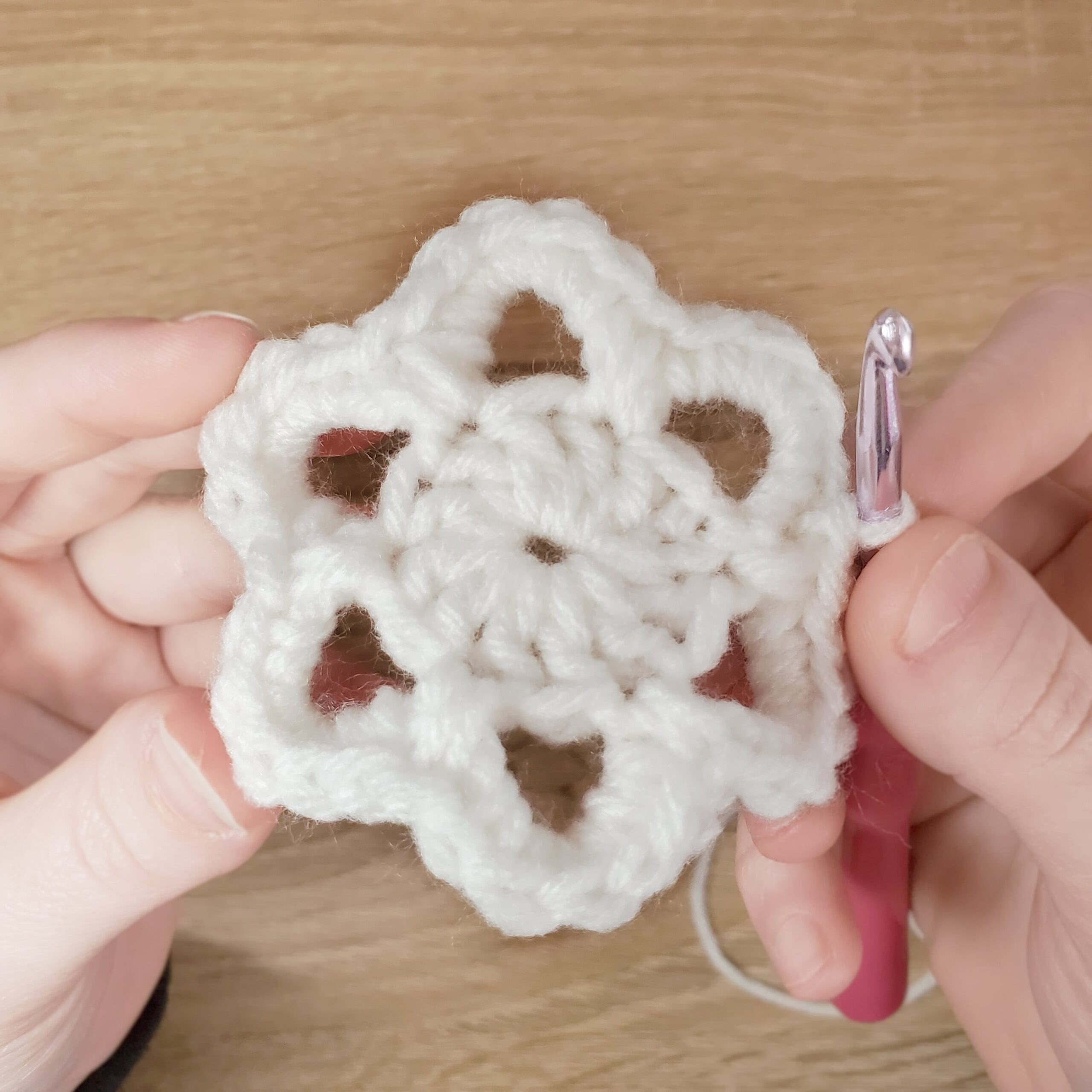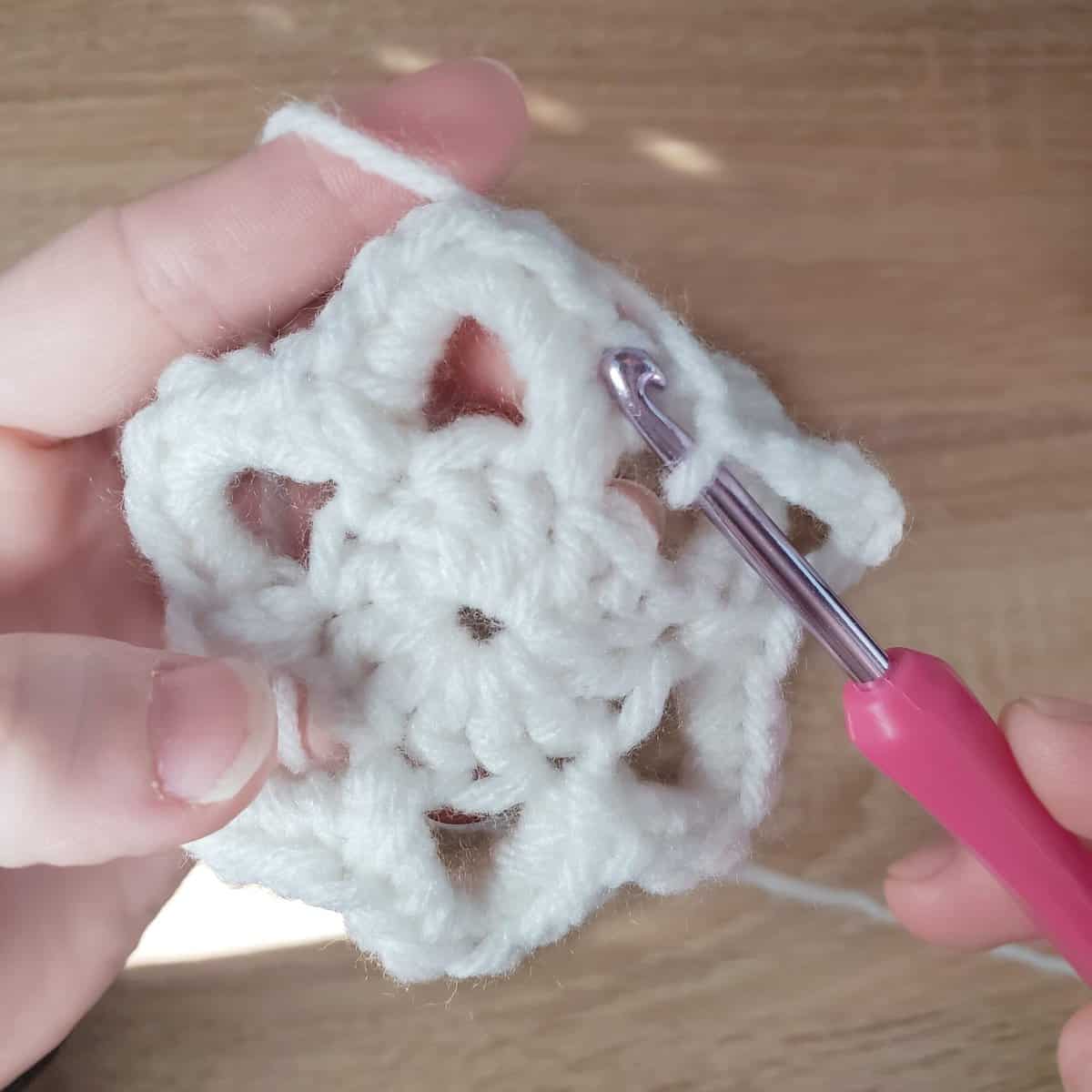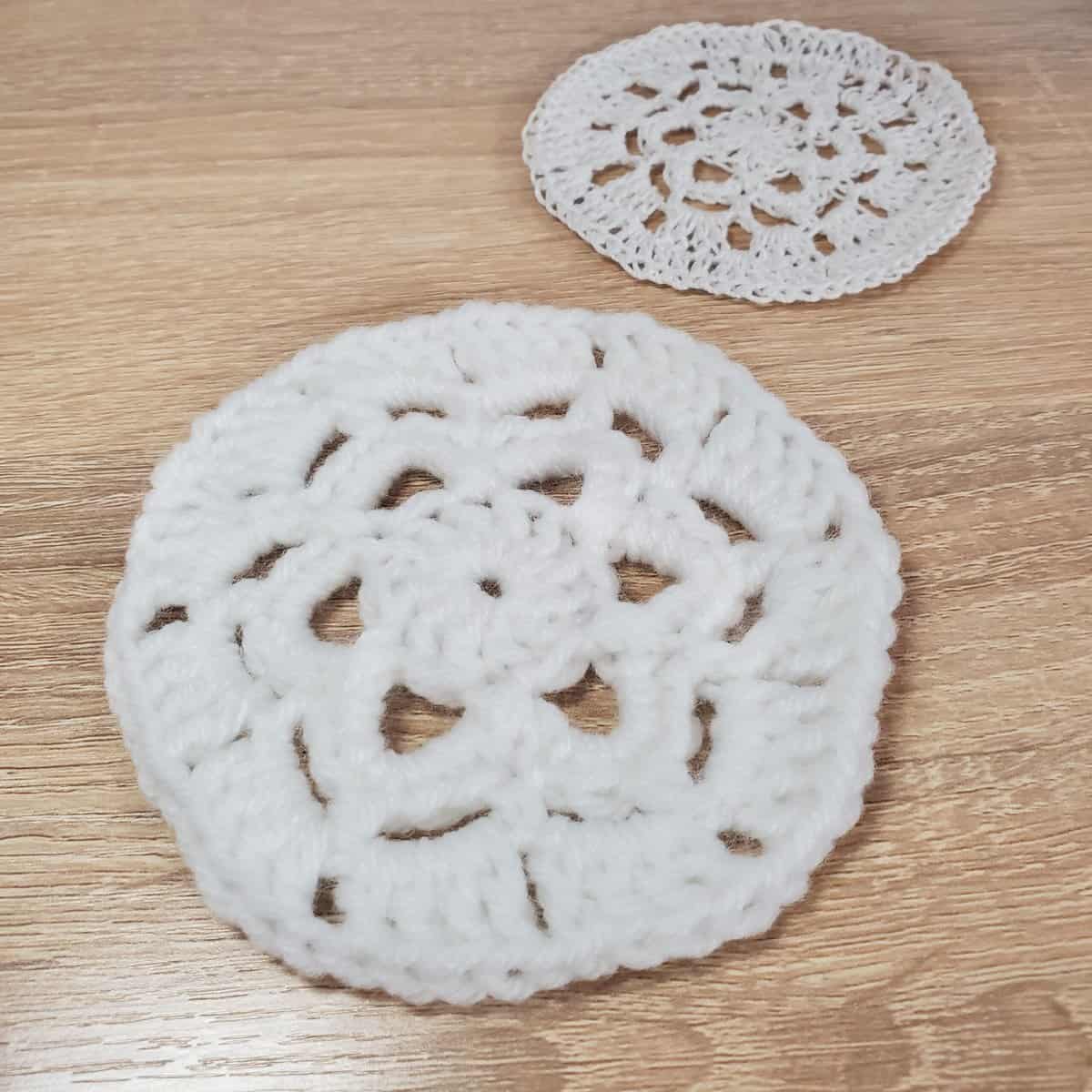Although many of the doilies that you see in stores today are made from paper or machine lace, there are still people who crochet doilies by hand.
Crocheted doilies were especially popular in the early days of crochet. They were a common home decor item featured on tables all throughout the house.
People still use doilies in this way today, and there are also many contemporary ways to display doilies.
Today, we’ll be talking about the history of crocheted doilies, some modern uses for them (including modern art!), and then, of course, how to actually go about creating one yourself!
I’ve created a simple doily crochet pattern, perfect for beginners.
History of Crochet Doilies
When people first learned how to crochet, they used mercerized cotton thread and small hooks, very different from the bulkier yarns used today.
Crochet doilies were one of the most common items that people made throughout the first century of the craft. Crochet doilies were primarily made using basic crochet stitches, although later they would also include textured stitches such as crochet bobbles.
Crochet doilies were seen all throughout Victorian homes in the 19th century. Junkbox Treasures shares:
“The Victorian young woman was expected to have a supply of doilies in her hope chest to be used when she set up home. These doilies were used most often for serving food and protecting furniture.”
Crochet doilies continued to be common in homes throughout the first several decades of the 20th century. They were considered a part of household etiquette in many homes.
A lunch table was not considered properly set if doily placemats were not part of the setting, and the finger bowl was often placed on a doily as well. Notably, crochet doilies were something you would see in a middle-class or upper-class home.
Junkbox Treasures also shares that the doily was an important part of a thing called a “Tussie Mussie”. This was a bouquet of flowers and herbs that was wrapped with a doily at the bottom.
Although you might not have heard the term before, it’s certainly possible that you’ve seen flower bouquets with doilies; they are especially common in crochet made for weddings.
Why Are They Called Doilies?
The following comes from Dora Ohrenstein, written in a 2011 Summer Interweave crochet article on doilies:
“When crochet doilies were first created they were often called antimacassars. That’s because they were placed on the backs of chairs to protect the furniture from the Macassar oil that many men used in their hair at the time. In the early 18th Century, there was a company brand named Doily that manufactured linens, and it is believed that the name for the object was derived from this popular brand (similar to how most people today will call tissues ‘Kleenex’). It is also possible, however, that the name Doily actually comes from a different name: The D’oyleys. There are several variants on the spelling and the original reason for naming this item a doily isn’t entirely known.”
Crochet Mandalas: A Contemporary Doily
As you look for crochet doily patterns, you may discover that many recent patterns are called crochet mandalas. A mandala is a round crochet pattern very similar to a doily.
The main difference is that a mandala is often worked with the intention to be used as a tool for mindfulness crochet (although that doesn’t necessarily have to be true).
In practical terms, a crochet mandala and a crochet doily are the same thing: a (usually) round, flat, crochet circle worked in the round and used as home decor.
Today’s crochet mandalas are often very colorful, whereas vintage crochet doilies were typically white or cream in color, and mandalas are often worked in yarn instead of thread.
Some people are simply turned off by the idea of making a “doily”. They equate it with something old and out of touch.
I believe we should honor all generations of our craft and celebrate the beautiful, intricate work that came before just like we appreciate the bold, colorful crochet of modern times.
That said, if you don’t like to say that you’re crocheting doilies, you might find that you feel perfectly comfortable telling people that you crochet mandalas instead!
Upcycled Crochet Doilies
Speaking of vintage crochet doilies, there are many people who love to collect them and actually upcycle them into modern creations.
It is easy to find vintage crochet doilies in thrift stores, antique shops, garage sales, and online stores. People take these and recombine them in new ways to create clothing, accessories, and fresh new home decor items.
Sometimes they dye the crochet doilies, and often they add additional crochet to the stitched-together pieces to complete the look.
Of course, you can also make your own crochet doilies and combine them in a similar manner as people do with vintage doilies.
Other Upcycled Crochet Doilies

Crochet doilies can be upcycled to create so many other items.
Of course, there are other wearables that can be crafted including skirts, shawls, and jackets. Crochet doilies can be stitched together to form blankets. A single crochet doily can be shaped to create a bowl.
Other items that people have created by upcycling doilies include bunting, purses, clocks, umbrellas, and even decorative stones.
Maillo is one of the most creative and prolific makers of upcycled doily items. They range from bowls and vases to pillows, hanging art, framed hoops, and even mobiles.
Crochet Doily as Artistic Medium
Upcycled crochet doilies are their own form of art but they aren’t the only way that doilies are used in art. In fact, crochet doilies are one of the most popular forms of crochet used in contemporary art.
One of the main reasons for this is that the doily is such an easily-recognizable symbol of women’s domestic life.
As such, artists who want to make commentary on this topic will incorporate doilies into their work in interesting ways to reflect varied beliefs about a woman’s place in the home, the value of domestic work, etc.
For example, Lindsay Arnold – who does paintings of doilies – says, “Domestic life provides an abundance of miscellaneous items existing only to make things look nice.”
Doily Heritage Project
One of the most interesting projects using crochet doilies is The Doily Heritage Project by Textile Fusion. This is a collection of photos of vintage doilies alongside stories from the makers or their family members.
This represents an amazing curation of the role that doilies – and crochet generally – played in the lives of women in the early 20th century.
Crochet is a craft that has been passed down through the generations, often through the women of the family, and this is seen in many of the stories that are shared as part of this project.
The project included a 2017 exhibit of the work.
Doilies as a Mask
Another interesting project is the photographic work of Francesca Lombardi and Giacomo Favilla in which they have placed crochet doilies as masks over the faces of the people in the images.
Cheeky Doilies
One way that women express feminist concerns about the “role of woman in the household” is by putting cheeky, raunchy, or provocative sayings on pretty household items.
We see this a lot in subversive cross-stitching, but you can also find it in crochet. Laura Mappin is one artist who makes cheeky doilies.
Doilies in Video
There are several artists who use doilies in videos to bring a very modern take to a classic crochet pattern. One example is light and sound installation artist Mariska de Groot.
Neo-Doilies
Asimina Chremos creates what she calls Neo-doilies, which begin as traditional doilies but then emerge into varied organic shapes with bright colors. It is a fun take on the classic doily.
Ceramic Doilies
There are several artists who incorporate crochet doilies into mixed media art including ceramics. The doily is imprinted into the ceramics to create a pattern.
For example, Shannon Donovan uses this technique to explore the beauty and artistic possibility of everyday domestic household items.
She also created a 366-day calendar making one ceramic doily per day and hanging them together on fabric. Urban artist Nespoon has also worked with ceramic doilies.
Crochet a Doily
Now that we’ve talked a bit about the history and modern uses of this crocheted item, you may be eager to try making one yourself!
Doilies are usually worked in the round as a circle but can be any shape, such as rectangular. There are countless crochet doily patterns including many terrific vintage patterns as well as newer, more modern patterns.
Today, I’ve created a simple mini doily pattern that uses worsted weight yarn and a 4.25mm crochet hook.
It’s a great way to practice making doilies without having to use crochet thread – especially if this is your first doily or you’re new to crochet.
It is a lovely open-work pattern and gives you some practice for some of the techniques you might use to create a doily or mandala!
To start, make a Magic Loop with 12 double crochet stitches. Slip stitch to the top of the first stitch to finish this row.

Row 2: Chain 5, then skip one stitch from the previous row. Slip stitch to the next stitch. Repeat this 5 more times all the way around the circle, ending with a slip stitch.

Row 3: Place 5 single crochets into the chain 5 from last row – you won’t be working into the stitches of the chain, but around the chain:

Then, create a single crochet spike stitch by working through the slip stitch from Row 2. Pull the spike stitch up to the same height as the single crochet of this row, like so:


Continue this pattern (adding 5 single crochet, then single crochet spike stitch) all the way around.

Row 4: Chain 3, then place a double crochet in the middle/third single crochet stitch from Row 3.


Chain 3 more, then place a single crochet into the single crochet spike stitch from Row 3.


Repeat this pattern all the way around – on your last single crochet, place a slip stitch instead to close the row.

Row 5: Slip stitch into the first chain 3 (not into the stitches of the chain, but around the chain like before!). Chain 2 (counts as first double crochet) then place 3 double crochet stitches in the chain 3 space. Chain 1, then place 4 double crochet stitches into the next chain 3 space. Repeat this (chaining one, then 4 double crochet stitches in the chain 3 space) all the way around this row. Close by slip stitching to the top of the chain 2 you made at the beginning of the row.

If you use crochet thread and a smaller hook, I find the finished doily looks better with an additional row of double crochet, placing two double crochet in the chain 1 space of row 5. However, if you’re only using worsted weight yarn, Row 5 is your last row!


Additional Reading – Crochet Books on Creating Doilies
There are tons of resources devoted only to creating doilies! Here are a few crochet books that you might like if you want to crochet doilies:
Doilies Updated has 9 crochet doily patterns that add a contemporary twist to vintage patterns.
Mandalas and Doilies to Crochet show that crochet doilies can serve as beautiful decor in contemporary homes.




Thank you for the post on doilies. I still use them and I want to make more. I prefer to knit mine as I just can’t seem to crochet tight enough with that little thread. It is a lost art that needs to be brought back. I love the clock doily, that is something I might think about doing in some of my rooms.
I love doilies. I have quite a few from garage sales, thrift stores, etc. I just collect them because they are so pretty and I so respect the woman’s work that went into making them. Thanks for this article on this art.
These doilies are beautiful! I know a few crocheters who like to frame doilies and then hang them on the wall.
Thank you for your article, I learned a few things I didn’t know. I Love to crochet doilies! I make them for gifts for family, friends and Thank yous to people that I appreciate what they have done in life. There is a calming effect when you can get into the rhythm of the stitches and before you know it you have made something of beauty with your hands.
I have a lot of my mother’s crocheted bureau scarves and doilies as well as a stack of my own that Mom had made over the years. They stem over 50 years of items. When I make them I prefer the smaller table doilies just to add an accent to some of my furniture. They may be outdated but it certainly covers up the dust when you don’t get to dusting!